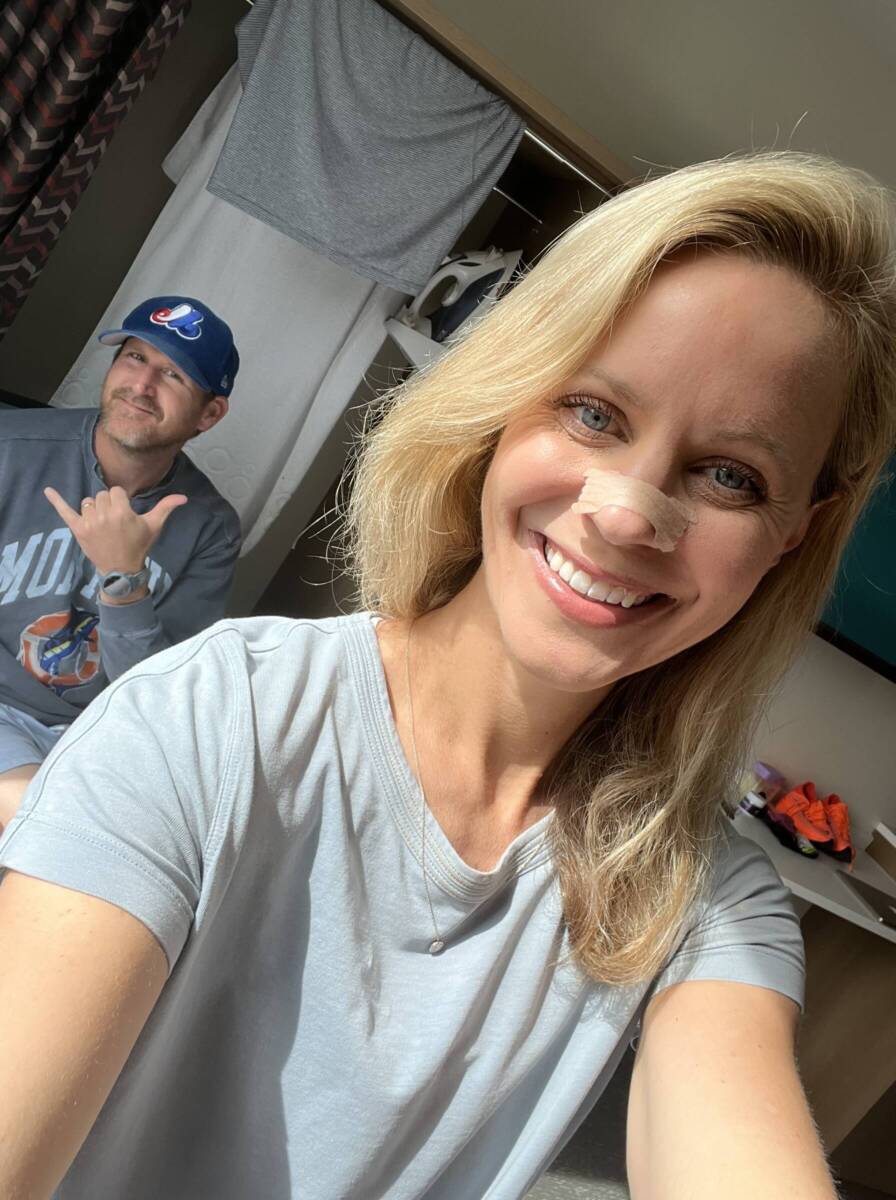My Experience: Does Pelvic Floor Therapy Work?
I will be the first to admit it. I am a hypocrite when it comes to pelvic floor physical therapy. I recommend to all my athletes I coach, pregnant or postpartum, to see a pelvic floor physical therapist. I’ve interviewed pelvic floor physical therapists on my podcast and on my website. Yet, I had never seen one. Why?

First, when I had my kids, no one ever talked to me about the importance of the pelvic floor. I didn’t even know pelvic floor PT existed. Then I had much bigger fish to fry
After I had my second child and started running more seriously, I began getting injured and injured and injured again. I tore my hamstring. Then I tore my plantar fascia. Then I developed quad compartment syndrome. Now I am dealing with a torn hip labrum. All these injuries have required so much time and money to heal and claw my way back from. You know what they all had in common, too? They were all on my right side!
Table of contents
When I finally bit the bullet
With my recent hip injury, it became clear that we need to look under the hood to find the root cause of all these injuries. Both my doctor and my physical therapist agreed—my major muscle groups were mostly balanced and strong. It had to be something smaller, further up the chain, that was leading to these injuries and keeping me constantly sidelined.
So, I finally made an appointment with a pelvic floor physical therapist—and kept it. In recent years, I had made appointments and cancelled them. But this time, I went, and the experience was both eye-opening and liberating…and I think it will be game-changing, too.
What is pelvic floor physical therapy?
A physical therapist is an exert medically trained in the function of muscles, joints, and nerves. A pelvic floor physical therapist specializes in the muscle and tissues of the pelvic floor.
They can identify whether you have weak pelvic floor muscles or hypertonic (overactive or tight or clenched), for example, and prescribe pelvic floor exercises and use certain therapies such as manual therapy or electrical stimulation therapy to help correct your pelvic floor problem and relieve pain.
What is the success rate of pelvic floor therapy?
I have yet to find someone who has seen a pelvic floor therapist and regretted it. A study has been done on the efficacy of pelvic floor physical therapy in its success in remedying pelvic floor disfunction.
In a study of almost 200 women, 55 percent of women saw an improvement in symptoms while 45 percent did not. Factors such as age and trauma during childbirth likely impacted the results, note the researchers.
How long does it take for pelvic floor therapy to help?
On average, it takes 4 to 6 weeks to notice improvement in pelvic floor physical therapy, though it can take as long as three months. Much of pelvic floor physical therapy is reviving the neuromuscular connections in the pelvic floor along with strengthening or relaxing pelvic floor muscles.
My Experience with Pelvic Floor Physical Therapy
As mentioned, it took me a while to finally go see a pelvic floor therapist. It honestly took me exhausting all my other options to get to this one. Everything happens for a reason, but I do think had I seen a pelvic floor physical therapist sooner, I probably would have sidestepped my injuries, maybe achieved my Olympic Trials Qualifying marathon time…I am going to stop there.
So, my pelvic floor physical therapist works with my doctor who has helped me with every major and minor health issue I’ve had in the past almost 15 years. Ironically, she is also the wife of my kids’ PE teacher! How is that for a small world!
The external exam
In my first physical therapy session, I filled out a form that asked about my medical history and symptoms. I do not have any of the classic pelvic floor dysfunction symptoms like leakage or pelvic pain. I then met with her and explained my running injury history and lamented that it has kept me from achieving my running goals.
She then began by having my stand with my back to her. She assessed where my pelvic bones were and my spine. She had me bend over and stand on one foot. After a few more movements, she stepped out and I undressed and put on a gown.
The internal exam
She returned for the internal exam which was very similar to a visit to my gynecologist in many ways. She palpated the pelvic muscles and had to try to contract different muscle regions. She also had me perform belly breaths (diaphragmatic breathing), contract my muscles like I was stopping the flow of urine and like I was letting out gas.
When she completed her assessment, she shared with me her findings. AND they all correlated with my injuries and intuition that my right leg internally rotated too much.
Her findings: My pelvic floor has a birth injury on my right side (likely from my first born getting stuck), causing me to be weak on my right side, too tight on my left. Critical, was her finding that a deep tiny hip muscle called the obturator internus was weak. This muscle is crucial for external rotation of the hip when running. When it is weak, it can really compromise the function of other leg and hip muscles and tissues. Mind blown.
My treatment plan
So, what did I do? The focus of my treatment was pelvic floor muscle training – that is reconnecting my brain to those muscles to turn them back on. It’s much different than any other physical therapy exercises I have done as it is not grand or strenuous movements. I literally lay down with my right leg bent, concentrate, and try to tense my OI muscle.

For my pelvic floor, I performed a Kegel where I begin with belly breathing, then move to closing the openings, and then lifting, working hard to have the right-side lift with the left.
The exercises require mental focus and intention—not something you can rush through, which I am prone to do. I did these exercises one to three times a day, though they only take a few minutes. After a few months, I was able to build my mileage up and train pain-free.
FAQs About the Pelvic Floor & Pelvic Floor Physical Therapy
What is the pelvic floor?
To review: the pelvic floor comprises of a group of muscles and connective tissues that stretch from the pubic bone at the front of the body to the tailbone at the back of the body. They support the bladder, bowels (organs responsible for digestion) and give structure to the spine and hips. The openings for the bladder, uterus and bowel, all pass through the pelvic floor.
Men also have a pelvic floor, though it is structurally different than women’s.
The pelvic floor has 4 main functions:
- Support pelvic organs and reproductive organs, including the bladder, uterus, prostate, and rectum.
- Help with bowel and bladder control.
- Stabilize the spine and pelvis
- Assist with sexual function.
Why runners should care about their pelvic floor health:
Our muscles are all connected and work together. If one is weak or overly tight, or not “turned on”, all the others are affected. With running, the stabilization comes from the core and pelvis, aka pelvic floor. If the pelvic floor muscles can’t do their part, then (with the repetition of running), other muscles or tissues are bound to pay the price.
It took me a long time to realize that. My hope is that this article helps it not take so long for you!
Who is at risk for pelvic floor issues?
Women more commonly have pelvic floor dysfunction or issues due to changes during pregnancy and trauma from childbirth.
But about a quarter of the adult population suffers from a pelvic floor disorder including urinary incontinence, pelvic pain, pelvic pressure, sexual problems, or pelvic organ prolapse. The risk for pelvic floor disorders increases with age, chronic constipation, and pregnancy (with the more pregnancies, the greater the risk).
Who should see a pelvic floor physical therapist?
Many people erroneously think you can just do Kegel exercises and be good to go. Pelvic floor therapy is so much more than Kegel exercises and Kegels could actually exacerbate your pelvic floor issues as a weak pelvic floor muscle and hypertonic pelvic floor muscle have similar symptoms. (I insist all runners I work with who recently had babies see a PF PT before I work with them as a running coach!).
That said, the following symptoms are common with pelvic floor dysfunction (weak or too tight):
- leaking urine when coughing, sneezing, laughing, or running
- fecal incontinence
- failing to reach the toilet in time
- pelvic pain or discomfort, including during intercourse
- passing wind from either the anus or vagina when bending over or lifting
- reduced sensation in the vagina
- tampons that dislodge or fall out
- a distinct bulge at the vaginal opening
- several or recurring injuries of the low back, hips, or high hamstring
Learn more about what to expect at your pelvic floor physical therapy appointment here.
Is pelvic floor therapy worth it?
If you live with urinary leakage, uncontrolled bowel movements, pain in the pelvic region, painful intercourse, or recurring running injuries or injuries, then I think it’s safe to say—100 percent, pelvic floor physical therapy is worth it. It can dramatically change your quality of life.
Everyone I have ever spoken to who has ever seen one uses words like “life-changing” to describe their experience. If you have questions, please feel free to reach out to me.






